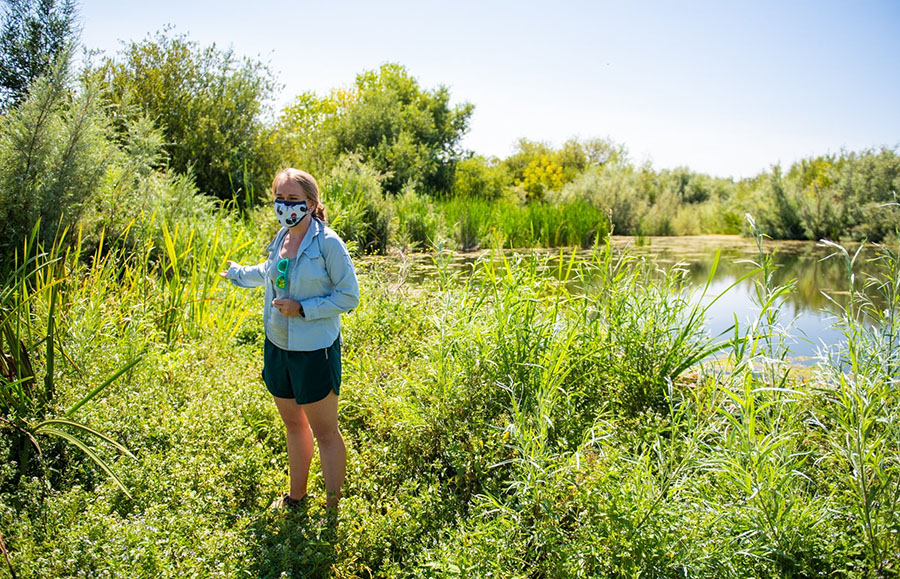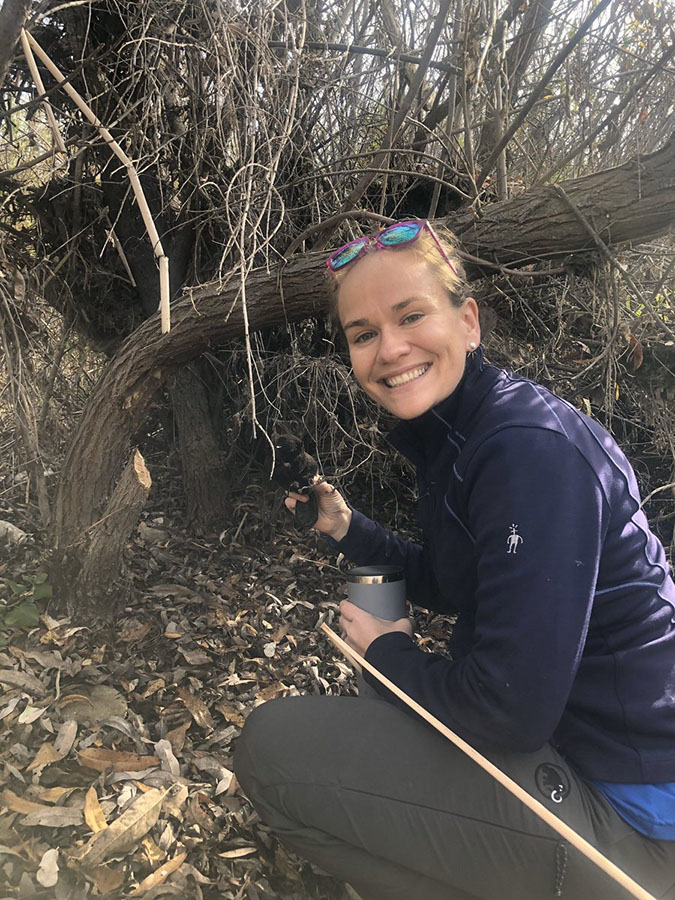 Oct. 13, 2020 — From the wine country to the desert, exhausted firefighters struggle to contain wildfires blazing across California.
Oct. 13, 2020 — From the wine country to the desert, exhausted firefighters struggle to contain wildfires blazing across California.
Recently released research by one CSU Channel Islands (CSUCI) faculty member shows firefighters might be getting help from some paddle-tailed wildlife living in streams, ponds and marshland across California. According to research done by Assistant Professor of Environmental Science & Resource Management (ESRM) Emily Fairfax, Ph.D., beavers might be nature's fire prevention specialists.
"My research was the first to show that if you have beaver damming in a creek, the area around the beaver dam is going to stay pretty green and not burn," Fairfax said. "They are creating fire-resistant patches in the landscape."
Fairfax's research into these furry firefighters has attracted the attention of a prestigious scientific journal and numerous media outlets around the country and Canada. In fact, World Wildlife Fund Canada (WWF-Canada) has awarded Fairfax a $3,790 grant in support of a project entitled "Remote Sensing to Identify Beaver Dams in Priority Areas in Newfoundland and Labrador."
Fairfax's research also appeared in several national publications and podcasts, including National Geographic, the National Association of Science Writers, the National Wildlife Federation's Artemis, and a highly-ranked ecology journal called Ecological Applications.
Before conducting research on beavers and fires, Fairfax did research on beavers and drought. Fairfax's research showed that by building dams, digging channels and changing small streams into broad wetland areas, the dams have the secondary effect of keeping plants green and lush, even during periods of drought. The channels the beavers dig act like a little drip irrigation system running through entire riparian areas.
This new research about beavers and fire shows that the dams, channels and broad wetland areas created by diverted streams helps keeping the area wet and plants green. When wildfires strike, the beaver wetlands are too wet to burn.
"I think this is great for California because we are to the point where we feel like we can't stop them, but what these beavers are showing us is that even if you can't stop fires, you can preserve parts of the landscape during a fire," Fairfax said. "That's important to conservation that the landscape can still function after a burn. Also, if these places don't burn, the animals can use it as a hiding spot. Otherwise, they can't escape."
Fairfax has presented her findings at conferences of the American Geophysical Union, the Geological Society of America, State of the Beaver and BeaverCon, a meeting of scientists, land managers, citizens and others.
The grant from WWF-Canada is for Fairfax to use remote sensing—Google Earth Pro—to give them more information for their latest restoration project. Specially, Fairfax is helping WWF-Canada find beaver dams on salmon rivers and tributaries near the Atlantic. Fairfax is being assisted by two ESRM students—Rhianna Torres and Jocelyn Adao.
Victoria Neville, WWF-Canada's senior specialist in fisheries and aquatic ecosystems, explained that salmon have evolved to leap or swim over beaver dams, but they are vulnerable to threats like warm waters and illegal fishing or poaching. Many times, beaver dams are viewed by salmon conservationists as a nuisance and are removed from fish migratory corridors, which drains the wetland and flushes away the juvenile salmon. WWF-Canada is using the research to further develop a plan to enable salmon passage while maintaining the beaver wetland.
"Cutting-edge researchers like Dr. Fairfax help us prioritize where our habitat-friendly interventions can have the most impact," Neville said. "We are excited about the developments in remote sensing from CSUCI as it directly helps us with our restoration work."
Neville added that she is hopeful the research could also help with other WWF-Canada priorities such as the effect of beaver wetlands on greenhouse gases.
 Fairfax is hoping her research leads to solutions to many environmental concerns. In terms of fire prevention in California, for example, it's possible to encourage beavers to build dams in areas vulnerable to fire by creating manmade beaver dams.
Fairfax is hoping her research leads to solutions to many environmental concerns. In terms of fire prevention in California, for example, it's possible to encourage beavers to build dams in areas vulnerable to fire by creating manmade beaver dams.
"They're called beaver dam analogs or BDAs," Fairfax said. "There are active beaver dam analog projects all over California, especially in the Sierras. When you build a BDA, it reaches the point where a beaver moves in. It's a really good way to get beavers to move in where we want them."
Beavers build dams all over California, including Ventura and Santa Barbara counties, Fairfax said, although she has less hard data on Ventura County.
"I haven't heard of an active beaver dam sighting in Ventura County since 2000, but I think that's because we're just not looking for them. One of my goals this year is to go find them," Fairfax said. "Santa Barbara has hundreds. In Santa Ynez, it's dam after dam after dam. They're in LA County, Bakersfield, Los Padres National Forest, everywhere."
Beavers have their detractors, but Fairfax hopes her research will help inform beaver management policies by helping lawmakers consider the good that beavers do.
"I think the biggest advantage is beavers work for free and they're already out there doing this," Fairfax said. "All you have to do is leave them alone and they will make our landscapes more fire-resistant, one patch at a time."
Photo credits: Photographer Brittany App and CSUCI Assistant Librarian Beth Blackwood
To view Fairfax's study: https://esajournals.onlinelibrary.wiley.com/doi/abs/10.1002/eap.2225
